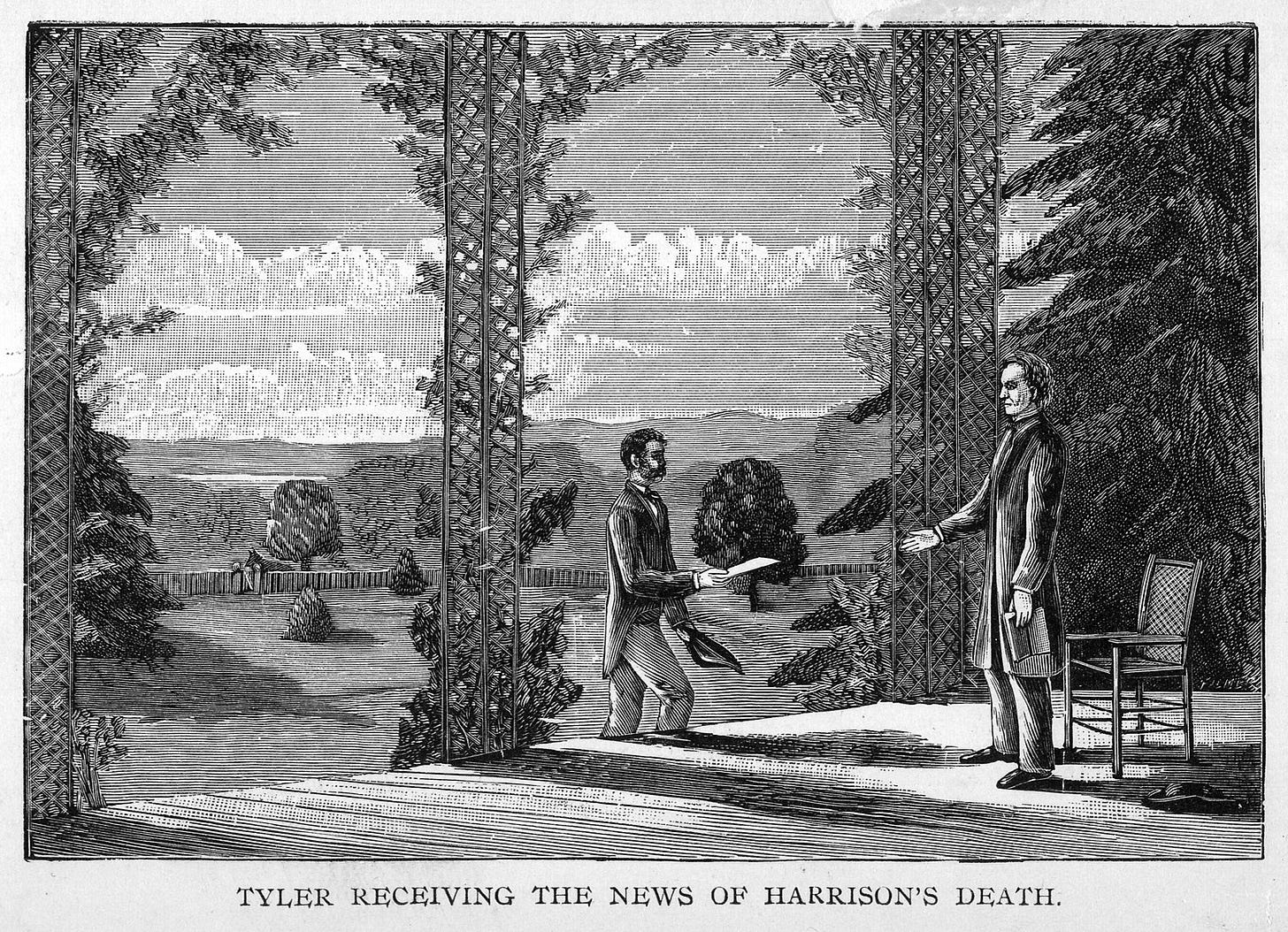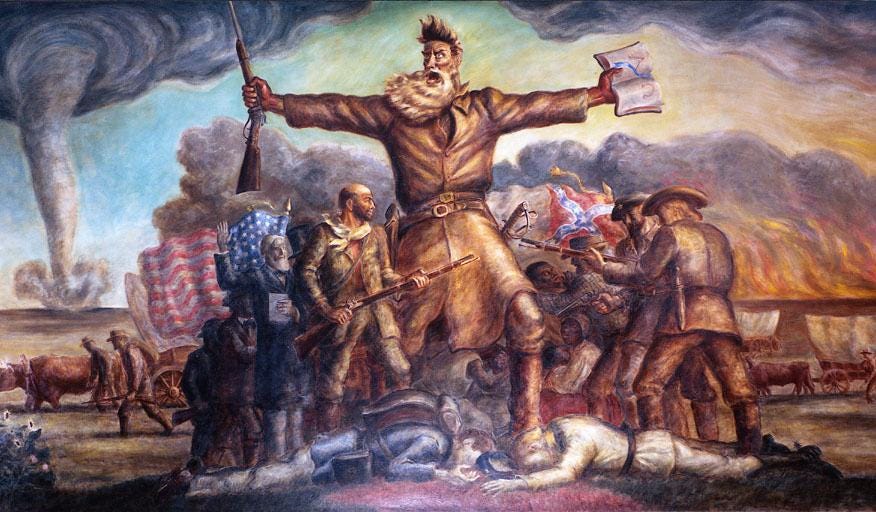And that claim is by the right of our manifest destiny to overspread and to possess the whole of the continent which Providence has given us for the development of the great experiment of liberty and federated self-government entrusted to us.
– John L. O'Sullivan, New York Morning News, 1845
America has been lucky to have fought few wars against our neighbors, Mexico and Canada. In the modern era, we have only known peace and (relative) cooperation. But our current, uhh, disagreements brought to my mind an earlier era, when Americans’ desire to spread across the continent ran across their borders (to say nothing of the Native Americans who actually lived there). Not everyone in the US supported aggressive territorial expansion, however, and many observers accurately feared the ramifications it would have on our politics. The story of Manifest Destiny is also the story of slavery. In the short term, expansionists got what they wanted, but their actions tore apart the factions of both political parties, and soon after, the country as a whole.
…And Tyler Too!

White Americans had been expanding west since the first European ships landed on the continent, but the concept of Manifest Destiny truly gained popularity during the debate over the annexation of Texas. Originally a Mexican state, Texas declared its independence in 1836. Its large population of settlers from the American South rebelled against the Mexican government’s attempts to curb their influence on the region — specifically, the recent ban on slavery. When Texans signaled their desire to join the Union as a slave state, US politicians mostly avoided the issue. Neither political party wanted to divide their northern and southern constituencies.
President John Tyler was a man without a party. He had been selected as the running mate to General William Henry Harrison’s successful 1840 campaign, which gave the Whigs their first presidential victory. As a member of the southern states’ rights faction, he didn’t actually agree with the economic views of party leaders like Kentucky Senator Henry Clay. When old man Harrison kicked the bucket one month into his presidency,1 Tyler suddenly became the head of a party he had little in common with. He vetoed major parts of the congressional Whig agenda, such as the re-establishment of the National Bank. He was expelled from the party, lost his inherited cabinet to mass-resignations,2 and faced impeachment charges. But Tyler asserted his place as the rightful president, rather than an interim placeholder (the Constitution was surprisingly unclear on this).
Tyler knew he needed a political shake-up to have any chance at a second term. He submitted his treaty for Texas Annexation to Congress in April 1844 (alongside a staunch defense of slavery by his Secretary of State, John C. Calhoun3). The bill was predictably voted down, but it forced politicians to take sides on a divisive issue.
America’s Most Successful One-Term President

Whigs continued to punt on Texas, nominating Henry Clay for the upcoming presidential election.4 Clay’s focus was economic issues. He disavowed annexation, but avoided tying the issue to the expansion of slavery. By trying to please everyone, he satisfied no one.
On the Democratic side, Tennessee politician (and Andrew Jackson protégé) James K. Polk upset former President Martin Van Buren for the party’s presidential nomination. Polk’s agenda was clear: more territory for the United States. In addition to supporting annexation, he also called for seizing New Mexico and California Territories from Mexico, as well as Oregon Territory from Canada Great Britain.5 The inclusion of Oregon was a clever strategy to make expansion more appealing to northerners and decouple the issue from slavery. President Tyler, seeing no path for himself but happy with his influence on the race, dropped out and endorsed Polk. Although the popular vote was close, Polk easily won the electoral college and the presidency. He promised to accomplish his goals in one term.
Once in office, Polk’s territorial claims threatened to spark armed conflict with Mexico and Great Britain. Knowing that another war against the US would be unpopular, Britain eventually accepted a compromise border at the 49th parallel. Things didn’t go as smoothly with Mexico. Fighting broke out between military forces near the Rio Grande, prompting the aptly-named Mexican-American War. The war was initially unpopular in the US, and Polk’s generals were openly critical of his decision-making. His Whig opponents attempted to juggle support for the troops (by voting in favor of war funding) with condemnation of his aggressive tactics.
Whigs performed well in the midterms, but Democrats bounced back as military and economic outlooks improved. Thanks to superior resources, America’s victory was inevitable. Mexico eventually relinquished New Mexico and Alta California for $15 million. As promised, Polk expanded US territory all the way to the Pacific Ocean in one term and chose not to seek re-election.6
Well, Well, Well, If It Isn’t The Consequences Of My Own Actions

Polk had skillfully united his party around Manifest Destiny, but the status of slavery in the newly acquired land was a question that could no longer be ignored. Although it was unlikely that slave plantations would flourish in the Southwest desert, the issue became a symbolic lightning rod for both northerners and southerners. Democratic presidential nominees in the 1850s endorsed Popular Sovereignty — the idea that residents of new states should vote on slavery, rather than defer to the Missouri Compromise — leading to a mass exodus of northerners to third parties.
Whigs similarly struggled to contain their internal disagreements. They managed to win back the presidency in 1848 by nominating another military general, Zachary Taylor. Southerners were happy that Taylor was a slaveholder, while northerners viewed him as a non-ideological moderate. Ultimately, his time in office7 became defined by the Compromise of 1850 — a series of five bills meant to settle the slavery debate, but in reality, pissing off everyone.8 All of this distracted from the Whigs’ core messaging, and they too bled support to third parties. With the death of leaders like Clay in the 1852, the party ceased to exist.
The Great Experiment of Liberty
The Whig Party infamously crumbled under the issue of slavery, but their internal divisions surrounding territorial expansion pointed to a party that never had full control of its coalition. Like modern Democrats, the Whigs were comprised of many factions that didn’t always see eye-to-eye. Untimely presidential deaths aside, party leaders failed to manage these factions effectively. They were often too afraid of alienating one side to craft a clear narrative. Because of this, they rarely controlled the national conversation, ceding political (and sometimes literal) ground to their opponents.
Manifest Destiny was a way for Democrats in the mid-1800s to unite around a nationalist goal. This evolved into an embrace of slavery, turning them into the party of the South. It’s sad to say, but Whigs probably wouldn’t have succeeded by supporting full abolition. However, what their eventual successors, the first Republicans, did differently was become the definitive representatives of the North. They made the stakes clear in a way that Whigs’ could not. Soon, they would expose southern Democrats as traitors, robbing them of their nationalist credentials. Today’s cultural divides are not entirely geographic. But in the face of rising nationalism, the opposition needs to focus less on coalitional prudence and more on presenting a strong narrative that makes the stakes clear.
It was, and still is, a common myth that Harrison (the oldest president until Ronald Reagan) died of pneumonia after giving a long inauguration speech in cold weather. In reality, the real culprit was most likely the contaminated drinking water in the White House. Spoilers: he wasn’t the only resident to die an early death around this time!
Two of Tyler’s replacement cabinet members (his Secretaries of State and Navy) were killed in a canon explosion in February 1844 during a ceremonial cruise aboard the USS Princeton. Tyler was also in attendance, but was safely below deck. Close call!
It goes without saying that Calhoun, Tyler’s third Secretary of State, was extremely racist. He started his political career as a relative moderate, but later became a pro-slavery leader. His belief in states’ ability to nullify federal laws was a major inspiration for southern secession.
As the most prominent figurehead of the Whig Party, Henry Clay ran for president three times and sought his party’s nomination most other years, too. As you probably know, he lost every time.
Oregon Territory had been shared between the US and Great Britain since the Monroe Administration. The most extreme expansionists argued that America should occupy all of the land up to Russian Alaska, prompting the latitude-inspired slogan, “54°40′ or Fight!”
Polk enjoyed the shortest retirement of any president that completed his term, dying of cholera shortly after returning home to Tennessee from Washington.
Grim post! Like Harrison, Taylor also died in office. He became sick after consuming too much cherries and milk(?) during Fourth of July festivities in 1850. Some thought he was poisoned, but I bet that bad White House water had something to do with it! Whigs were 0-2 on completing their presidential terms.
The main components were: 1) admit California as a free state, 2) pass the Fugitive Slave Act, forcing northerners to return escaped slaves to the South, 3) ban the sale of slaves in Washington, DC, 4) Define the northern and western borders of Texas, and 5) establish new territories in the West without banning slavery.



